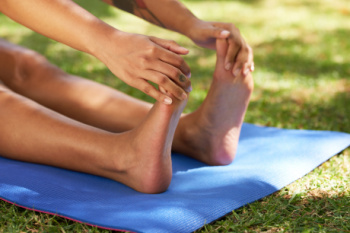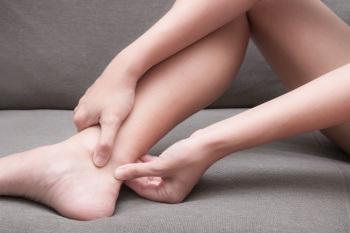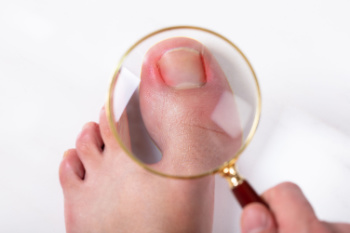Items filtered by date: July 2024
Stretches Can Help the Feet

Standing for prolonged periods of time can cause aches and pains in your feet and lower limbs. In addition to wearing comfortable shoes and taking breaks to sit and walk around, one other way that you can prevent or relieve pain is to stretch. A lunging calf stretch can help prevent cramping in the calf muscles, plantar fasciitis, and other foot problems. It can also promote circulation. To do this stretch, stand one step away from a wall and place both palms flat against it. Step your left foot back and bend your right knee into a lunge. Keep your toes pointing forward and slowly push your left heel toward the ground until you feel a stretch in your calf. Hold and then repeat on the opposite foot. To learn more about the benefits of stretching your feet, it’s suggested that you consult with a podiatrist.
Stretching the feet is a great way to prevent injuries. If you have any concerns with your feet consult with Lesly Honore, MD, DPM from New York. Our doctor will assess your condition and provide you with quality foot and ankle treatment.
Stretching the Feet
Being the backbone of the body, the feet carry your entire weight and can easily become overexerted, causing cramps and pain. As with any body part, stretching your feet can serve many benefits. From increasing flexibility to even providing some pain relief, be sure to give your feet a stretch from time to time. This is especially important for athletes or anyone performing aerobic exercises, but anyone experiencing foot pain or is on their feet constantly should also engage in this practice.
Great ways to stretch your feet:
- Crossing one leg over the others and carefully pull your toes back. Do 10-20 repetitions and repeat the process for each foot
- Face a wall with your arms out and hands flat against the wall. Step back with one foot and keep it flat on the floor while moving the other leg forward. Lean towards the wall until you feel a stretch. Hold for 30 seconds and perform 10 repetitions for each foot
- Be sure not to overextend or push your limbs too hard or you could risk pulling or straining your muscle
Individuals who tend to their feet by regular stretching every day should be able to minimize foot pain and prevent new problems from arising.
If you have any questions, please feel free to contact our office located in Hempstead, NY . We offer the newest diagnostic and treatment technologies for all your foot care needs.
Managing Your Non-Diabetic Foot Infection

Non-diabetic foot infections can arise from various sources, including cuts, puncture wounds, or fungal infections. Symptoms often include redness, swelling, and pain, potentially accompanied by drainage or fever if severe. Causes range from minor injuries to exposure in moist environments. Immediate treatment involves cleaning the affected area with mild soap and water, applying an antibiotic ointment, and covering with a clean bandage. Keeping weight off the affected foot and elevating it can aid healing. It is important to monitor for worsening symptoms or signs of infection. For persistent infections, particularly those spreading or not responding to initial care, seeking prompt evaluation by a podiatrist is key. This type of doctor can assess the infection's severity, provide stronger antibiotics or drainage procedures if necessary, and ensure comprehensive care to promote healing and prevent complications. If you are experiencing these symptoms, it is suggested you schedule an appointment with a podiatrist for specialized treatment.
Wound care is an important part in dealing with diabetes. If you have diabetes and a foot wound or would like more information about wound care for diabetics, consult with Lesly Honore, MD, DPM from New York. Our doctor will assess your condition and provide you with quality foot and ankle treatment.
What Is Wound Care?
Wound care is the practice of taking proper care of a wound. This can range from the smallest to the largest of wounds. While everyone can benefit from proper wound care, it is much more important for diabetics. Diabetics often suffer from poor blood circulation which causes wounds to heal much slower than they would in a non-diabetic.
What Is the Importance of Wound Care?
While it may not seem apparent with small ulcers on the foot, for diabetics, any size ulcer can become infected. Diabetics often also suffer from neuropathy, or nerve loss. This means they might not even feel when they have an ulcer on their foot. If the wound becomes severely infected, amputation may be necessary. Therefore, it is of the upmost importance to properly care for any and all foot wounds.
How to Care for Wounds
The best way to care for foot wounds is to prevent them. For diabetics, this means daily inspections of the feet for any signs of abnormalities or ulcers. It is also recommended to see a podiatrist several times a year for a foot inspection. If you do have an ulcer, run the wound under water to clear dirt from the wound; then apply antibiotic ointment to the wound and cover with a bandage. Bandages should be changed daily and keeping pressure off the wound is smart. It is advised to see a podiatrist, who can keep an eye on it.
If you have any questions, please feel free to contact our office located in Hempstead, NY . We offer the newest diagnostic and treatment technologies for all your foot care needs.
Causes of Ankle Pain in Runners

Ankle pain, which plagues many runners, stems from the repetitive stress placed on the joints with every step. Runners take approximately 1,700 steps per mile, each one contributing to the cumulative strain on their ankles. The primary causes of ankle pain in runners include ankle sprains, strains, tendonitis, and stress fractures. Ankle sprains involve stretched or torn ligaments, resulting in pain, swelling, and difficulty in moving the ankle. Strains, which are injuries to the tendons, can cause pain, muscle spasms, and cramping. Tendonitis, the inflammation or irritation of a tendon, is often triggered by overuse, wearing improper footwear, repetitive motion, and conditions like low arches or flat feet. Symptoms can include a dull ache, tenderness, and limited swelling. Stress fractures, which are tiny cracks in the bones caused by repetitive force and overuse, can result from excessive mileage, in addition to sudden increases in running distance and changes in running surfaces. Symptoms include worsening pain that diminishes with rest and limited swelling. If you are experiencing ankle pain from running, it is suggested that you schedule an appointment with a podiatrist for an exam and treatment options.
Ankle pain can be caused by a number of problems and may be potentially serious. If you have ankle pain, consult with Lesly Honore, MD, DPM from New York. Our doctor will assess your condition and provide you with quality foot and ankle treatment.
Ankle pain is any condition that causes pain in the ankle. Due to the fact that the ankle consists of tendons, muscles, bones, and ligaments, ankle pain can come from a number of different conditions.
Causes
The most common causes of ankle pain include:
- Types of arthritis (rheumatoid, osteoarthritis, and gout)
- Ankle sprains
- Broken ankles
- Achilles tendonitis
- Achilles tendon rupture
- Stress fractures
- Bursitis
- Tarsal tunnel syndrome
- Plantar fasciitis
Symptoms
Symptoms of ankle injury vary based upon the condition. Pain may include general pain and discomfort, swelling, aching, redness, bruising, burning or stabbing sensations, and/or loss of sensation.
Diagnosis
Due to the wide variety of potential causes of ankle pain, podiatrists will utilize a number of different methods to properly diagnose ankle pain. This can include asking for personal and family medical histories and of any recent injuries. Further diagnosis may include sensation tests, a physical examination, and potentially x-rays or other imaging tests.
Treatment
Just as the range of causes varies widely, so do treatments. Some more common treatments are rest, ice packs, keeping pressure off the foot, orthotics and braces, medication for inflammation and pain, and surgery.
If you have any questions, please feel free to contact our office located in Hempstead, NY . We offer the newest diagnostic and treatment technologies for all your foot care needs.
Understanding Tarsal Tunnel Syndrome
 Tarsal tunnel syndrome is a condition characterized by the compression of the tibial nerve as it travels through the tarsal tunnel, a narrow space on the inside of the ankle. This tunnel houses several vital structures, including the tibialis posterior tendon, the flexor digitorum longus tendon, and the posterior tibial artery and vein. When the tibial nerve is compressed, it can lead to pain, tingling, and numbness in the foot. The tibialis posterior tendon helps support the arch of the foot, while the flexor digitorum longus tendon aids in flexing the toes. The posterior tibial artery and vein are essential for blood circulation to the foot. If you have pain in this part of your foot, it is suggested that you consult a podiatrist who can diagnose and treat tarsal tunnel syndrome.
Tarsal tunnel syndrome is a condition characterized by the compression of the tibial nerve as it travels through the tarsal tunnel, a narrow space on the inside of the ankle. This tunnel houses several vital structures, including the tibialis posterior tendon, the flexor digitorum longus tendon, and the posterior tibial artery and vein. When the tibial nerve is compressed, it can lead to pain, tingling, and numbness in the foot. The tibialis posterior tendon helps support the arch of the foot, while the flexor digitorum longus tendon aids in flexing the toes. The posterior tibial artery and vein are essential for blood circulation to the foot. If you have pain in this part of your foot, it is suggested that you consult a podiatrist who can diagnose and treat tarsal tunnel syndrome.
Tarsal tunnel syndrome can be very uncomfortable to live with. If you are experiencing tarsal tunnel syndrome, contact Lesly Honore, MD, DPM of New York. Our doctor can provide the care you need to keep you pain-free and on your feet.
Tarsal Tunnel Syndrome
Tarsal tunnel syndrome, which can also be called tibial nerve dysfunction, is an uncommon condition of misfiring peripheral nerves in the foot. The tibial nerve is the peripheral nerve in the leg responsible for sensation and movement of the foot and calf muscles. In tarsal tunnel syndrome, the tibial nerve is damaged, causing problems with movement and feeling in the foot of the affected leg.
Common Cause of Tarsal Tunnel Syndrome
- Involves pressure or an injury, direct pressure on the tibial nerve for an extended period of time, sometimes caused by other body structures close by or near the knee.
- Diseases that damage nerves, including diabetes, may cause tarsal tunnel syndrome.
- At times, tarsal tunnel syndrome can appear without an obvious cause in some cases.
The Effects of Tarsal Tunnel Syndrome
- Different sensations, an afflicted person may experience pain, tingling, burning or other unusual sensations in the foot of the affected leg.
- The foot muscles, toes and ankle become weaker, and curling your toes or flexing your foot can become difficult.
- If condition worsens, infections and ulcers may develop on the foot that is experiencing the syndrome.
A physical exam of the leg can help identify the presence of tarsal tunnel syndrome. Medical tests, such as a nerve biopsy, are also used to diagnose the condition. Patients may receive physical therapy and prescriptive medication. In extreme cases, some may require surgery.
If you have any questions please feel free to contact our office located in Hempstead, NY . We offer the newest diagnostic and treatment technologies for all your foot and ankle needs.
Ingrown Toenail Management
 An ingrown toenail occurs when the edge of a toenail grows into the surrounding skin, causing pain, swelling, and sometimes infection. This condition is often seen in the big toe and can result from improper nail trimming, wearing tight footwear, or injury to the toe. When the nail pierces the skin, it creates an entry point for bacteria, leading to redness, pain, and pus formation. Managing an ingrown toenail involves soaking the affected foot in warm water to reduce swelling, gently lifting the nail edge, and applying antibiotic ointment. It is important to avoid cutting the nail too short or rounding the corners, as this can worsen the condition. Complications from untreated ingrown toenails can include severe infections, abscess formation, and in extreme cases, bone infections. To prevent ingrown toenails, trim nails straight across, wear properly fitting shoes, and maintain good foot hygiene. If the condition persists or worsens, it is suggested that you
An ingrown toenail occurs when the edge of a toenail grows into the surrounding skin, causing pain, swelling, and sometimes infection. This condition is often seen in the big toe and can result from improper nail trimming, wearing tight footwear, or injury to the toe. When the nail pierces the skin, it creates an entry point for bacteria, leading to redness, pain, and pus formation. Managing an ingrown toenail involves soaking the affected foot in warm water to reduce swelling, gently lifting the nail edge, and applying antibiotic ointment. It is important to avoid cutting the nail too short or rounding the corners, as this can worsen the condition. Complications from untreated ingrown toenails can include severe infections, abscess formation, and in extreme cases, bone infections. To prevent ingrown toenails, trim nails straight across, wear properly fitting shoes, and maintain good foot hygiene. If the condition persists or worsens, it is suggested that you
Ingrown toenails can become painful if they are not treated properly. For more information about ingrown toenails, contact Lesly Honore, MD, DPM of New York. Our doctor can provide the care you need to keep you pain-free and on your feet.
Ingrown Toenails
Ingrown toenails occur when a toenail grows sideways into the bed of the nail, causing pain, swelling, and possibly infection.
Causes
- Bacterial infections
- Improper nail cutting such as cutting it too short or not straight across
- Trauma to the toe, such as stubbing, which causes the nail to grow back irregularly
- Ill-fitting shoes that bunch the toes too close together
- Genetic predisposition
Prevention
Because ingrown toenails are not something found outside of shoe-wearing cultures, going barefoot as often as possible will decrease the likeliness of developing ingrown toenails. Wearing proper fitting shoes and using proper cutting techniques will also help decrease your risk of developing ingrown toenails.
Treatment
Ingrown toenails are a very treatable foot condition. In minor cases, soaking the affected area in salt or antibacterial soaps will not only help with the ingrown nail itself, but also help prevent any infections from occurring. In more severe cases, surgery is an option. In either case, speaking to your podiatrist about this condition will help you get a better understanding of specific treatment options that are right for you.
If you have any questions, please feel free to contact our office located in Hempstead, NY . We offer the newest diagnostic and treatment technologies for all your foot care needs.
